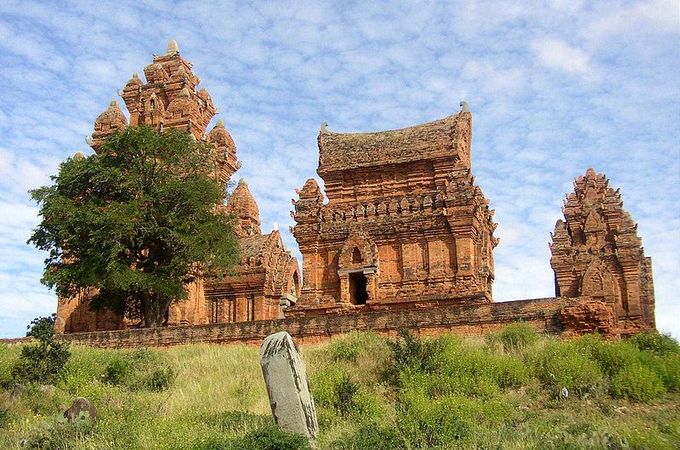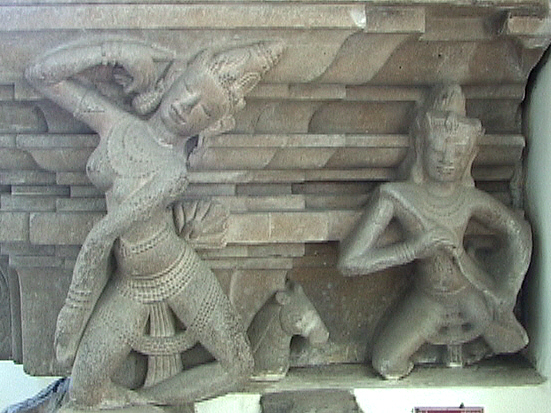22.12: Vietnamese Art
- Page ID
- 53085
Champa Art in Early Vietnam
Champa art and architecture in Vietnam was been formed by the interaction of local customs with Indian, Chinese, and Indonesian influences.
Learning Objectives
Describe the art and architecture of the Indic kingdom of Champa
Key Takeaways
Key Points
- Vietnamese art and architecture has a long, rich history and has been shaped by the interaction of local customs with foreign cultures . The Indic kingdom of Champa produced strongly Indianized Hindu-Buddhist art, with additional influences from Cambodia, China, and Java.
- Champa was an Indic civilization that flourished along the coasts of central and southern Vietnam between 500 and 1500 CE, lying on important trade routes that linked India, China, and the Indonesian islands.
- The artistic legacy of Champa consists of sandstone sculptures , both free-standing and in relief , and brick temples. Cham art and architecture synthesized themes from Hinduism , Buddhism , and different indigenous cults.
- The art and architecture of Champa reached its peak between the 7th and 10th centuries, after which it fell into a state of gradual decline. Worn out by external conflict, the kingdom fell in 1471 CE.
Key Terms
- relief: A type of artwork in which shapes or figures protrude from a flat background.
Overview: The Art of Vietnam
Vietnamese art and architecture has a long, rich history and has been shaped by the interaction of local customs with foreign cultures. While the art of Northern Vietnam was strongly influenced by Chinese domination and reflected Confucian and Mahayana Buddhist traditions, southern and central Vietnam were a part of the Indic kingdom of Champa (ca. 500–1500 CE). This region produced strongly Indianized Hindu-Buddhist art, with additional influences from Cambodia, China, and Java.
The Art of Champa
Champa was an Indic civilization that flourished along the coasts of central and southern Vietnam between 500 and 1500 CE, lying on important trade routes that linked India, China, and the Indonesian islands. The artistic legacy of Champa consists primarily of sandstone sculptures, both freestanding and in relief, and brick buildings. Most of the surviving art expresses religious themes, synthesized from Hinduism, Buddhism, and different indigenous cults.
The art and architecture of Champa reached its peak between the 7th and 10th centuries, after which it fell into a state of gradual decline. The civilization weakened under persistent conflict with external forces, culminating in 1471 CE with the conquest and obliteration of the capital Vijaya by the Đi Việt of northern Vietnam.
Champa Temples
The Cham built their temples from red brick. Temple complexes usually consisted of several parts: the kalan or sanctuary , usually in the form of a tower and used to house the deity ; the mandapa or entry hallway; the kosagrha or fire-house, used to house the temple’s valuables and to cook for the deity; and the gopura or gate-tower leading into the walled templed complex. This structure was typical for Hindu temples in general, not just in Champa but across Greater India. Some of the most significant temples of historical Champa include the temple of Yan Po Nagar outside of Nha Trong, dedicated to the Hindu goddess Bhagavati and built between the 8th and 13th centuries, and Po Klaung Garai near Phanh Rang.

Temple of Po Klaung Garai, Phanh Rang, Vietnam: The profile of this 13th century temple includes all the buildings typical of a Cham temple. From left to right one can see the kalan, the attached mandapa, the saddle-shaped kosgrha, and the gopura.
Champa Sculptures
The Cham were famous for both their freestanding sandstone statues and their relief carvings, with some preference for the latter. The subject matter was mostly drawn from the legends and religious traditions of India, and the sculptures feature Hindu and Buddhist deities, such as Shiva, Vishnu, Shakti (the divine feminine creative power in Hinduism), and Avalokiteshwara (the bodhisattva of compassion).
Cham sculptors also erected numerous lingas, or phallic posts connected with Shiva, and created some images that depart from Indian subject matter to reveal something of the lives and customs of the Cham. A few bronze sculptures and metal decorative items remain as well, dating from the 10th century CE. These include statues of Mahayana Buddhist deities such as Avalokiteshwara and Tara (a Buddhist female meditation deity), and bear a strong resemblance to the Indian Buddhist style of Amaravati.

The Dancers’ Pedestal of Tra Kieu: 10th century Cham sculpture, sandstone. The figures are a dancing apsara (Hindu celestial nymph) and a gandharva (Hindu male nature spirit) musician.
Chinese Influences in Vietnamese Art
Northern Vietnamese art and architecture was highly influenced by over a century of Chinese domination.
Learning Objectives
Evaluate the influence of Chinese culture on Vietnamese art
Key Takeaways
Key Points
- The art of Northern Vietnam was strongly influenced by Chinese domination (111 BCE—939 CE), reflecting Confucian and Mahayana Buddhist traditions.
- During the millennium of Chinese domination, artists in the north of Vietnam began to apply newly learned Chinese techniques to art in conjunction with traditional indigenous methods, including advanced bronze-casting.
- The period of rule under the Lý Dynasty (1009–1225) is commonly considered a golden age in Vietnamese art, and its ceramics became famous across Southeast Asia and the Far East.
- Vietnam was conquered and ruled by the Ming Dynasty of China between 1407 and 1427 CE; during this period, many classical Vietnamese books were burned under an extreme process of sinicization .
Key Terms
- sinicization: To make Chinese in character or to change or modify by Chinese influence.
Overview
Vietnamese art and architecture has a long, rich history and has been shaped by the interaction of local customs with foreign cultures . Unlike the Champa art of southern and central Vietnam, the art of Northern Vietnam was strongly influenced by Chinese domination (2nd century BCE—10th century CE) and reflected Confucian and Mahayana Buddhist traditions.
The Art of Northern Vietnam
Early Chinese Domination
During the millennium of Chinese domination (111 BCE–939 CE), artists in the north of Vietnam began to apply newly learned Chinese techniques to art, specifically ceramics, in conjunction with art created using traditional indigenous methods, including advanced bronze-casting. Chinese-influenced philosophies such as Confucianism , Mahayana Buddhism , and Taoism left lasting impressions on Vietnamese culture and art, which continued to flourish between the 10th and 15th centuries after Chinese dominance had waned. However, the ceramics from this period were considerably influenced by the Tang and Song dynasties of China.
The Lý Dynasty
The period of rule under the Lý Dynasty (1009–1225 CE) is commonly considered a golden age in Vietnamese art, and its ceramics became famous across Southeast Asia and the Far East. Many Vietnamese landmarks were constructed during this period. The One Pillar Pagoda , for example, was built in 1049 and is widely regarded as one of Vietnam’s most iconic Buddhist temples. The Temple of Literature is a Confucian temple in Hanoi, built in 1070 and reconstructed between 1225—1400, that housed the Imperial Academy, Vietnam’s first national university. The temple layout is similar to that of the temple at Qufu, Shandong, Confuscius’ birthplace. It covers an area of over 54,000 square meters, including the surrounding Lake of Literature, a park, and the interior courtyards, which are enclosed by a brick wall. In front of the Great Gate are four tall pillars, and on either side of the pillars are two stelae, or stone tablets commanding horsemen to dismount.

Temple of Literature, Main Gate, Hanoi: Built in 1070, this Confucian temple is one of the greatest Vietnamese landmarks constructed during the Lý Dynasty.
The Ming and Subsequent Dynasties
Vietnam was conquered and ruled by the Ming Dynasty of China between 1407 and 1427 CE. This period of Chinese domination was extremely harsh, and many classical Vietnamese books were burned as an extreme process of sinicization was enforced. Consequently, the art of this period was heavily influenced by the Ming Dynasty, a process that continued even after the liberation of Vietnam by the Lê Dynasty (1428–1788). The Nguyễn Dynasty, the last ruling dynasty of Vietnam, witnessed a renewed interest in ceramics and porcelain , which became famous and were imported to imperial courts across Asia.
- Curation and Revision. Provided by: Boundless.com. License: CC BY-SA: Attribution-ShareAlike
- Art of Champa. Provided by: Wikipedia. Located at: en.Wikipedia.org/wiki/Art_of_Champa. License: Public Domain: No Known Copyright
- Apsara Gandharva Dancer Pedestal Tra Kieu. Provided by: Wikipedia. Located at: en.Wikipedia.org/wiki/File:Apsara_Gandharva_Dancer_Pedestal_Tra_Kieu.jpg. License: Public Domain: No Known Copyright
- Vietnamese art. Provided by: Wikipedia. Located at: en.Wikipedia.org/wiki/Vietnamese_art. License: CC BY-SA: Attribution-ShareAlike
- Art of Champa. Provided by: Wikipedia. Located at: en.Wikipedia.org/wiki/Art_of_Champa. License: CC BY-SA: Attribution-ShareAlike
- Buddhist art. Provided by: Wikipedia. Located at: en.Wikipedia.org/wiki/Buddhist_art%23Vietnam. License: CC BY-SA: Attribution-ShareAlike
- Boundless. Provided by: Boundless Learning. Located at: www.boundless.com//art-history/definition/sinicization. License: CC BY-SA: Attribution-ShareAlike
- relief. Provided by: Wiktionary. Located at: en.wiktionary.org/wiki/relief. License: CC BY-SA: Attribution-ShareAlike
- le-of-literature-main-gate.@2x.jpeg. Provided by: Wikipedia. Located at: en.Wikipedia.org/wiki/Temple_of_Literature,_Hanoi. License: Public Domain: No Known Copyright
- Vietnamese Art. Provided by: Wikipedia. Located at: en.Wikipedia.org/wiki/Vietnamese_art. License: CC BY-SA: Attribution-ShareAlike
- Buddhist Art. Provided by: Wikipedia. Located at: en.Wikipedia.org/wiki/Buddhist_art%23Vietnam. License: CC BY-SA: Attribution-ShareAlike

